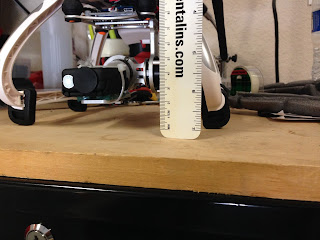I had been out of RC-hobby for so long, things had changed (electrics weren't really popular back then) . I didn't even own a 2.4ghz radio-set. My piloting skills were pretty rusty and I had never flown a hobby-class helicopter before.
Between starting with smaller WLT-v262 (as a quad outdoor flight trainer) and then buying the pre-built Nova, I think it worked out rather well. But even after buying the Quanum Nova PnF model, there was a bit of a learning curve ... getting up to speed with:
- Electric quadcopter hardware (ESCs, Flight-Controllers, etc.)
- APM hardware in general (Arduino-based FC, GPS, compass, etc.)
- Advanced APM hardware tech like Telemetry
- MissionPlanner and DroidPlanner software
- Quadcopter cameras and gimbals
- FrSky Taranis and OpenTX
- Helicopter piloting skills (so you don't crash :)

While the stock uBlox GPS-Module works acceptably in clear-sky weather ... in over-cast clouds or back-yards (close trees blocking quad's view-angle to satellites) ... it doesn't work so good. It ends-up providing low satellite detection and a high HDOP (poor GPS signal quality). Aware of it now and not much of a problem since I only fly in "nicer weather (party-cloudy or better) and I also use DroidPlanner (on my Android tablet) to monitor GPS-signal in real-time.
 The out-of-control crash-landing into the neighbor's tree last October was a major set-back. Final cause of crash was determined to be ... "attempted RTC (Return-To-China) fly-away" due to flakey GPS (RTL/ Fail-Safe failure). I've had my share of hardware problems involving GPS (turned-out to be bad/flakey cables). Also, with vibrations causing Wobble-Of-Death (WoD). All that is corrected now, and the Nova has proven to be a dependable aircraft in recent flights over the last months.
The out-of-control crash-landing into the neighbor's tree last October was a major set-back. Final cause of crash was determined to be ... "attempted RTC (Return-To-China) fly-away" due to flakey GPS (RTL/ Fail-Safe failure). I've had my share of hardware problems involving GPS (turned-out to be bad/flakey cables). Also, with vibrations causing Wobble-Of-Death (WoD). All that is corrected now, and the Nova has proven to be a dependable aircraft in recent flights over the last months.The new camera gimbal upgrade is great. So great in fact that I know that I always want at least one multi-rotor aircraft running a good camera on a gimbal. The problem is that the gimbal's extra 185-grams seems to have put the Nova close to it's payload weight limit. It is no longer a nimble quad that can be flown close to ground and obstacles. It's more like an aircraft that you carefully fly up to a safe altitude and use for Aerial Photography (AP). In it's new weight class, the quad seems to be under-powered. This also causes it to be more susceptible to the forces of high winds.
To be perfectly honest, I think some of the problem might also be my (slowly advancing) helicopter piloting skills. I simply don't get that much "stick-time" to practice (I need to resolve that if I want to progress). Currently, I still rely on a powerful and nimble aircraft to get me out of hairy situations. I still have a fairly constant fear of crashing and of a fly-away (due to GPS failure). The extra weight has definitely made it less responsive. Hopefully, I can tune some of that away.
Anyway, I still love this hobby. For me, it's always been about the hardware building, electronics integration, programming config, and the piloting challenge of RC-Aircraft (now robotic ones).
It is possible to stay safe and push-your-limits at the same time. I think that is part of the fun and excitement of the hobby.
The Quanum Nova (Cheerson CX-20 clone) has proven to be a good aircraft and valuable introduction into the world of RC multi-rotors and ArduCopter for me. Sure, it's only a little 350-class quad and it's (nice looking) plastic body is kind-of fragile (if you crash-land), but I still like having it in my "hanger". It is GPS capable and it's been a good model in my progression through the hobby.

































